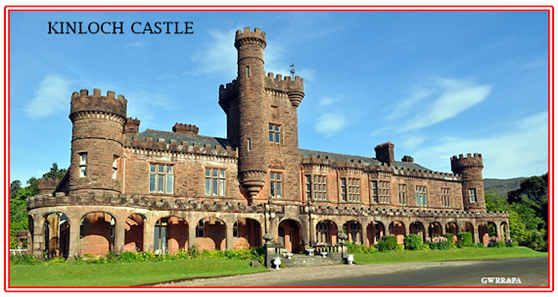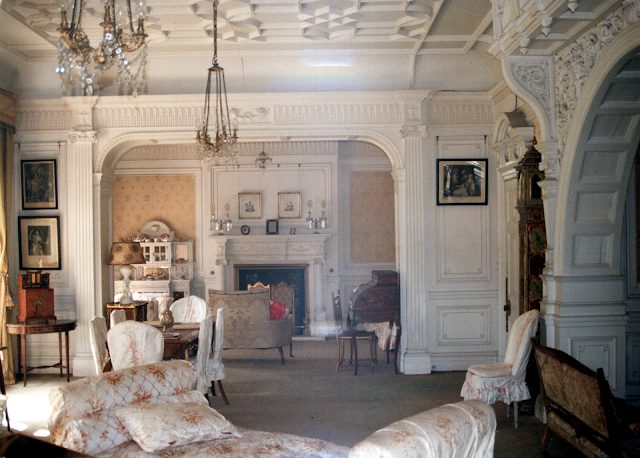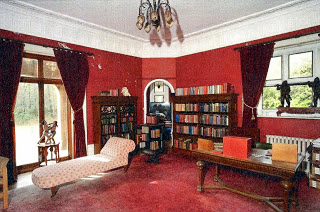CAN YOU HELP?
DO YOU KNOW SOMEONE WILLING TO HELP
FOR
FUTURE GENERATIONS?
I have posted 122 papers on Kinloch Castle,
here are four more :
http://kinlochcastle.blogspot.com/2016/05/
(Some Mysteries Solved - The Nero Bell)
http://kinlochcastle.blogspot.com/
(World Tour - India, Gokak Cotton Mills, Bangalore
http://kinlochcastle.blogspot.com/2024/07/kilmory-isle-of-rum-laundry-and-deer.html
(Kilmory Laundry and Cambridge University Deer Research Unit)
http://kinlochcastle.blogspot.com/2014/
(Japanese Warriors and Chinese Artefacts)
Remember ... ... the Island was
purchased with tax-payers money in 1957 -
it belongs to the nation.
AUTHOR'S BACKGROUND:
PROPOSAL FOR A SUSTAINABLE FUTURE
FOR KINLOCH CASTLE
(the full Proposal can be read below this introduction.)
The eighteen point November 2016 Proposal was written by Stewart Sandison,
today South Highland Operations Manager for NatureScot,
formerly Scottish Natural Heritage.
Mr. Sandison says: "...
any future owner will need to contribute towards three key objectives;
(1) securing the conservation and preservation of Kinloch Castle,
(2) contributing to the sustainability of the Rum Community
and enhancing nature on the island, and,
(3) promoting enjoyment and minimising the castle's impact on the natural environment."
BUT WHAT ABOUT THE CONTENTS ?
YOU CAN READ MORE ABOUT KINLOCH CASTLE AND ITS CONTENTS -
GOOGLE: ART TREASURES OF KINLOCH CASTLE
Kinloch
Castle remains a unique and outstanding example
of a fully furnished late Victorian / Edwardian
hunting lodge.
It was purchased along with the 26,400 acre island on which it is located
a peppercorn price by a Conservative Government on 28 February1957
from Monica, Lady Bullough, and the Trustees of her late husbands estate
tax-payers money, it belongs to the nation.
*
Kinloch Castle
is located at the head of Loch Scresort on the east coast of the 26,400 acre
Isle of Rum National Nature Reserve, Scotland.
Island and Castle combine both
the social and natural heritage of this Inner Hebridean Island over millennia.
Used until
recently as a hostel for visitors the castle could accommodate at least
forty-eight and was much enjoyed by visitors and university study groups from
around the world. Its licensed bistro offered breakfast and evening meals,
complementing the overnight visitor experience.
Since the
closure of the hostel by Scottish Natural Heritage (SNH), a Scottish Government
funded agency, overnight visitors have reduced dramatically. Today
accommodation is provided in a new, self-catering twenty bed bunk house plus a
camp site, both run by the Island Community. Some households offer bed and
breakfast.
This loss of
overnight accommodation and reduction in visitor numbers has had an adverse
impact on jobs and the economy to the extent that the resident island community
is now back in the twenties whereas previously, after years of uncertainty, it
had grown to around forty. Rum retains a junior school, (which has encouraged
young families to the island), a licensed General Store / post office and
tearoom in the Community Hall.
Kinloch Castle
Hostel and Bistro offered seasonal employment, and attracted many hundreds of
visitors who patronised the shop and tea room. Records from the 1990’s
show up to 10,000 visitors a year. There is proven potential.
The
dramatic reduction in overnight accommodation, resident population and now
threat of demolition, are directly contrary to SNH obligations
to enhance
public access, support local communities and in the 1957 Acquisition Agreement
“to maintain Kinloch Castle”.
Today's politicians should put right the total
failure of their
predecessors to place Kinloch Castle with its contents in-situ in the hands of a more appropriate body.
predecessors to place Kinloch Castle with its contents in-situ in the hands of a more appropriate body.
*
Please
read the following -
PROPOSAL FOR A
SUSTAINABLE FUTURE FOR KINLOCH CASTLE
and
make your opinions known by contacting the Scottish Parliament directly:
>< + >< + >< +>< + >< + >< + ><
 |
The Castle is surrounded on three sides by a glazed walkway which deflects water from the very foundations of the building.
In the late 1990's material arrived to replace the timber which had rotted leaving large sections without glass and in a hazardous state.
EDITOR: But the allocated time ran out before the job was half completed, the contractors left leaving much of the work unfinished to this day, the replacement material where it stood. Where is it now?
RIGHT: the repaired south facing section with galvanised struts replacing rotted timber and new lead flashing,
BELOW: An unfinished corner allows rain access into stonework where pointing has crumbled. On Rum, with its exceptionally high rainfall, keeping water out of all the buildings is a priority.
Photographs and descriptive text George W. Randall
5. The castle
has deteriorated over the years largely due to water ingress which has affected
the fabric of the building and the interior. We have developed a number of
restoration proposals aiming to secure a future for the building, but have not
to date been able to secure the necessary funds to take them forward. Our more
recent focus has been on the implementation of a conservation plan to reduce
the deterioration of the building.
6. The castle
currently functions as a visitor attraction and as such is significant to the
local economy. A visitor survey revealed that over one third of visitors to Rum
came to visit the castle with over half of all survey respondents partaking of
a castle tour.
7. In 2013, SNH
undertook a new look at the options for the future of Kinloch Castle. This
project (referred to as Stage 1) involved all major stakeholders and produced
an options appraisal for uses of Kinloch Castle. At the request of the Environment Minister,
this focused exclusively on a range of positive options for: potential uses for
the castle building; ownership models; and management of the castle’s artefact
collection. In particular, it
highlighted two options (‘Restoration to museum and visitor accommodation’ and
‘Restoration/ conversion to museum and mixed residents/ visitor accommodation),
with associated variations, which were worthy of working-up, through a second
stage of work (Stage 2) into a more fully developed business case.
*
Update
8. Stage 2 of the
Kinloch Castle’s future project recently developed a business case for the
castle, focusing on the two previously identified preferred options relating to
the provision of a museum and residential accommodation. This work was
undertaken by Savills. The business case (Executive summary in Annex 1)
presents an arrangement which is flexible in providing a range of residential
accommodation along with retention of the museum. The study highlights the
importance of the castle in attracting visitors to the island and notes
critical issues facing the island community. Key findings are:
* The overall
cost of the project is nearly £13M (excluding VAT and work to upgrade the
roads, electricity and water supply and to develop the gardens). A cumulative
financial subsidy of approximately £237,000 would be required to cover expected
losses in the first four years of operation. Based on current predictions (May
2016) it is estimated that the business will reach breakeven in year 5 of
operation and generate an annual surplus of £50k by year 10. Ongoing revenue
funding from a variety of sources will always be difficult but could achieve a
degree of success.
 |
| The six panes of original stained glass windows in the Great Hall. (Photograph and descriptive text George W. Randall) |
* Key funders
identified are the Heritage Lottery Fund and Historic Environment Scotland but
other public sector funding will be needed to meet the full capital costs. The
preferred delivery vehicle is a building preservation trust, its charitable
status giving the greatest opportunity for raising money from the widest range
of funding sources.
* Although there
are a wide range of risks associated with achieving a restored and viable
Castle, the option of ‘doing nothing’ could have significant negative
socio-economic effects on the island and wider area. There are also significant
issues associated with selling the building.
9. In September,
further essential work to address dry rot and asbestos work has revealed
considerable further deterioration of the steel framework. At this stage we do not know the additional
cost this may incur but it is likely to be considerable. Given that the steel frame is integral to the
structure of the castle, our best estimate is that this may add between £5-10
million to the total costs.
10. As a result
of SNH’s financial position, we have been unable to secure financial resources
this year to enable us to progress the current repair programme element of the
Castle Conservation Plan in 2016/17. We have however undertaken some
unscheduled but urgent masonry works and as a consequence we have had to
commission a report on the structural integrity of the castle and are reviewing
the Conservation plan.
11. Future budget availability will be subject to this
year’s spending review outcome. However the expectation is that the current
financial position will not improve and the current constraints on implementing
the repair programme will continue leading to further deterioration of the
structure.
12. We continue to have no operational need for Kinloch Castle and are conscious of the ongoing resource commitment that is required to achieve and then maintain the castle as wind and watertight. We acknowledge the significant complexities and increasingly difficult resource implications of delivering long-term positive options.
12. We continue to have no operational need for Kinloch Castle and are conscious of the ongoing resource commitment that is required to achieve and then maintain the castle as wind and watertight. We acknowledge the significant complexities and increasingly difficult resource implications of delivering long-term positive options.
 |
| The oak paneled Games Room with raised viewing dais. Full size Burroughes and Watts Billiard Table and score board. (Photographs and descriptive text George W. Randall)  |
Risk Management Implications
13. As a result
of our continued ownership of, and responsibility for Kinloch Castle, and our
limited budget for maintenance works there is a likelihood that it will
deteriorate further with a risk of the following impacts:
* Financial:
a. Pressure to
try to secure sufficient funds within an environment of a decreasing SNH
budget.
b. Possible
financial sanctions placed upon us by the Local Authority for failure to meet
our statutory obligations as owner of a Listed Building.
* Legal:
a. As an owner of a Category A Listed Building we are obliged to take reasonable steps for the care and maintain of the property and we could be at risk of being served an improvement notice by the Local Authority.
b. If we fail to act on the improvement notice the local Authority could instruct that the necessary works be undertaken and seek reimbursement from us.
a. As an owner of a Category A Listed Building we are obliged to take reasonable steps for the care and maintain of the property and we could be at risk of being served an improvement notice by the Local Authority.
b. If we fail to act on the improvement notice the local Authority could instruct that the necessary works be undertaken and seek reimbursement from us.
*
Reputational:
a. As a
responsible public body we would fail to meet our obligations under ownership
of a listed building and the Scottish Historic Environment Policy for public
bodies.
b. We would fail
to meet reasonable public expectations of a standard expected of a Public Body.
c. We would fail to meet the expectations of stakeholders with regard to Kinloch Castle.
c. We would fail to meet the expectations of stakeholders with regard to Kinloch Castle.
d. We would
expose the community to an adverse economic impact if we had to close the
Castle to visitor tours, as a result of deterioration.
* Stakeholder:
a. As a responsible public body we have engaged with the key stakeholders and could be seen to have raised expectations which will subsequently remain unfulfilled.
a. As a responsible public body we have engaged with the key stakeholders and could be seen to have raised expectations which will subsequently remain unfulfilled.
b. Failing to
meet stakeholders’ expectations now will erode trust and confidence in us being
able to meet our responsibilities in the future.
Discussion
14. We have been
trying to find an acceptable and affordable future for Kinloch Castle for over
a decade. In that time, the condition of
the building has continued to deteriorate despite considerable sums spent to address
the most serious issues.
15. The options
are stark: we either find a way to generate significant funds over many years
to invest in renovating the building and securing a cost effective use for the
building, or we accept that the castle has no future and should be demolished.
16. The first
option has a multitude of variations including a range of future uses and
funding models, many of which are explored by the Savills work. They could also include private sale and
private investment. To take any of them
forward though we need to transfer the risks, principally financial, to those
able to manage them.
17. Equally, the
second option has a range of risks – reputational, legal and financial – which
we need to share with others.
18. Given the
sums involved, and level of influence required to manage the risks around these
two options, we recommend that the Chairman invite the Cabinet Secretary to
explore this through a summit meeting of the key interests.
Author: Stewart
Sandison
Date: November 2016
Contact: stewart.sandison@snh.gov.uk
*
Kinloch Castle – Isle of Rum – May 2016 Feasibility Report
Executive Summary
* This second
stage feasibility study on Kinloch Castle, undertaken by Savills, was
commissioned by Scottish Natural Heritage (SNH) to focus in on two previously
identified options relating to the provision of a museum and residential
accommodation of varying types.
* In appraising
the existing situation the study draws on the considerable amount of work
previously undertaken on the Castle during the last decade and identifies the
substantial repairs SNH has instructed to ensure that the building remains
substantially wind and watertight. It notes the critical issues facing the
island specifically communications, the socio-economic situation and
infrastructure emphasizes the importance of addressing these areas to allow the
Castle project to proceed smoothly.
* With the aid
of preliminary layouts, the study presents a potential arrangement which is
flexible in providing a range of residential accommodation, (self-catering/
hotel accommodation, taster accommodation for potential residents) designed to
meet changing circumstances and cater for a variety of events. The proposals
note the importance of the Castle in attracting visitors to the island and
identify the key areas of the castle which should be retained as the museum,
accessible to the public and partially open for event use.
*
*
The
Ballroom - viewed from the Minstrel’s Gallery -
has an arched ceiling
originally painted dark
blue in which a number of small lights “twinkled” like stars in the night sky.
Delicately
shaded side lights and a magnificent central chandelier of Waterford Cut
Crystal add
to the ambiance of the room in which the Bullough’s guests would
dance
the night away.
(Photographs and descriptive text George W. Randall)
*
* The key
funders are seen as the Heritage Lottery Fund and Historic Environment Scotland
but other public sector funding will be needed to meet the full capital costs.
Key to raising funds will be a person with appropriate and highly developed
fundraising skills.
* A developed
business plan demonstrates the financial viability of the project as well as
pointing out the caveats and shows how a number of models and scenarios could
work for the proposed layout and lead to a profit making situation over a period
of time. Marketing and maintaining the standard of the product will be critical
in achieving the final outcome.
* The overall
cost of the project, excluding major external works is nearly £13 Million
(excluding 20% Value Added Tax).
* Based on the current settings for the financial
variables in the model it is estimated that the business will reach break-even in year 5 of operation and generate an annual surplus of £50,000 by year
10. A cumulative financial subsidy of approximately £237,000 would be required
to cover expected losses in the first four years of operation.
 |
| The Empire Room. Before the arrival of Lady Bullough this south facing room was Sir Georges Library, opening into a magnificent domed Conservatory, regrettably long since gone as is the way with all things wooden unless maintained. The magnificent Conservatory circa. 1900. The library we see today was the original Business Room / Castle Office. Lady Bullough was the eldest daughter of French aristocrat the 4th Marquis de la Pasture and upon her marriage to Sir George, as with her drawing room, quickly commandeered the south facing rooms of the Castle re-furnishing her husband's former library with French engravings and fine porcelain. DOUBLE CLICK ON THIS LINK to view my Blog: https://www.blogger.com/blog/post/edit/3149945780622106744/4216589569849091792 * |
* An endowment
fund that will generate interest and therefore a continuing revenue stream will
help reduce long term risks and provide a better chance of ensuring
sustainability. If an investment return of 3% could be achieved, a fund value
of approx. £800,000 would be required to generate an annual income of £25,000.
This is the predicted value of the average annual income shortfall of the
museum for the first 10 years.
* The preferred
delivery vehicle is seen to be a building preservation trust with the
appropriate stake holders represented on its board. Its charitable status gives
it the greatest opportunity for raising money from the widest range of funding
sources. It would be able to transition into a management trust to run the
project once restoration and conversion was complete.
* There are
significant issues associated with selling the building and any return is
likely to be very limited.
* The castle has
considerable potential for holding luxury, group and corporate events making
use of the wide range of accommodation and event spaces.
* Ongoing
revenue funding from a variety of sources to help top up the costs of
maintaining the Castle will always be difficult but if properly managed could
achieve a degree of success.
* The Castle grounds have the potential to enhance the activities in the Castle. The designed landscape to a degree can be used as a setting for events but any designs should be kept simple to keep maintenance costs at a minimum. The Gazebo and Squash Court have the potential to be small self-catering units. A decision on the future of the Steading building should be delayed until a decision on the future of the Castle is made. If the Castle project proceeds, the Steading building could usefully be used for activities associated with the building contract. The walled garden would be ideal for horticultural activities to the benefit of the Castle and community.
* From a
socio-economic point of view a refurbished castle will inevitably help support
the island and wider community, increasing economic activity and visitor
numbers.
* There are a
wide range of risks associated with achieving the objective of a restored and
viable Castle but the option of ‘doing nothing’ could have significant negative
socio-economic effects on the island and wider area.
* The overriding
objective must be to achieve a sustainable solution for the Castle and this can
only be done by ensuring that everyone including all stake holders involved in
the project remain totally focussed on a successful outcome and are fully aware
of the consequences of failure. The cost of failure to the island and wider
community, the present custodian, the public sector, central government and all
other stakeholders is likely to be considerably more than the cost of success.
So, what happens next - restore it or lose it?
NOT AN ACCEPTABLE OPTION !!
DON'T TRUST TO OTHERS
MAKE YOUR CONCERNS KNOWN
MAKE YOUR CONCERNS KNOWN
UPDATED 25 SEPTEMBER 2024










































Would there be a possibility of utilising prisoners to help restore
ReplyDeletethe castle with their labour? This is a labour intensive project.
It would help prisoners and instead of them languishing unproductively in prison cells they could give something back to the country.
It costs around £200 a day to house a prisoner.I am not suggesting very dangerous prisoners but possibly prisoners that are minor offenders to go to the island and do something positive. Just a thought.
James Robson jakrobson@gmail.com